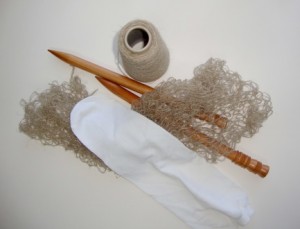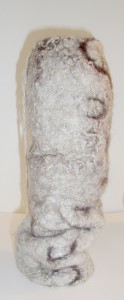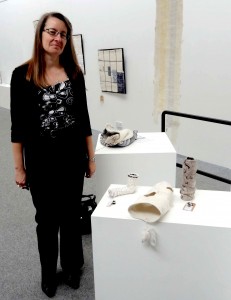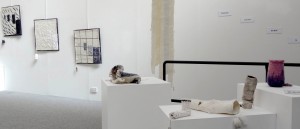Process and Evaluation
The design for this longer straight sock was intended to be a fragile, free standing vessel form. The pattern was added by knitting together fine spun jute. The knitted section provided an interesting texture on the outside of the vessel. The whole piece is about how being disabled means that we are in some ways forever fragile – that our personal independence has become limited. I selected Yak as a wool layer for the inside, enabling wool on both sides to integrate. Yak is a soft durable wool, likened to what I feel life is like living with a disability and also because it has soft loft to it and hairy texture. This was lightly needle felted from the inside which left a layer of fine hairs on the outside of the liner, adding to the build-up of texture and tonal quality, whilst felting in an even flat layer on the inside. A foam resist was used for this process from which the sock was rolled back to present the outside, keeping the yak wool in place.
Bubble wrap was inserted carefully to provide the next resist and to form the shape. This resulted in a tube almost as long as my arm. White merino was carefully layered over the knitted jute in an uneven way to produce a variation in the pattern – this was then rolled around the sock. Small amounts of white merino have been added using a single barbed needle to ensure that the jute remains in place and to make one side whiter than the rest. To provide further variation dark brown merino sections add curves to reflect the jute and provide even more variation in the pattern. When satisfied, the wet felting process began and this was completed by hand. The whole was rinsed and spun in the washer resulting in the final piece being approximately a third smaller. The final shape was formed and the whole set to dry over a reasonably high heat source.
The only difficulty was the removal of small amounts of bubble wrap which were caught by the barbed needle and stuck to the inside. These were removed during further hand felting and shaping. The thinner areas are evident and provide added interest when examined. Feedback has been positive in respect of the design, the materials used, and its aesthetic.
The shapes created in the pattern and form reflect both the fragility and strength in life, and how sometimes we have control, and how others are imposed by our experiences. It is up to individuals to decide what shape they wish to be, to be aware of their choices, and how those choices shape them.
Moira West, Daniel Series, It’s what shapes us’, March 2012, 28 x 8 x 7 cm




